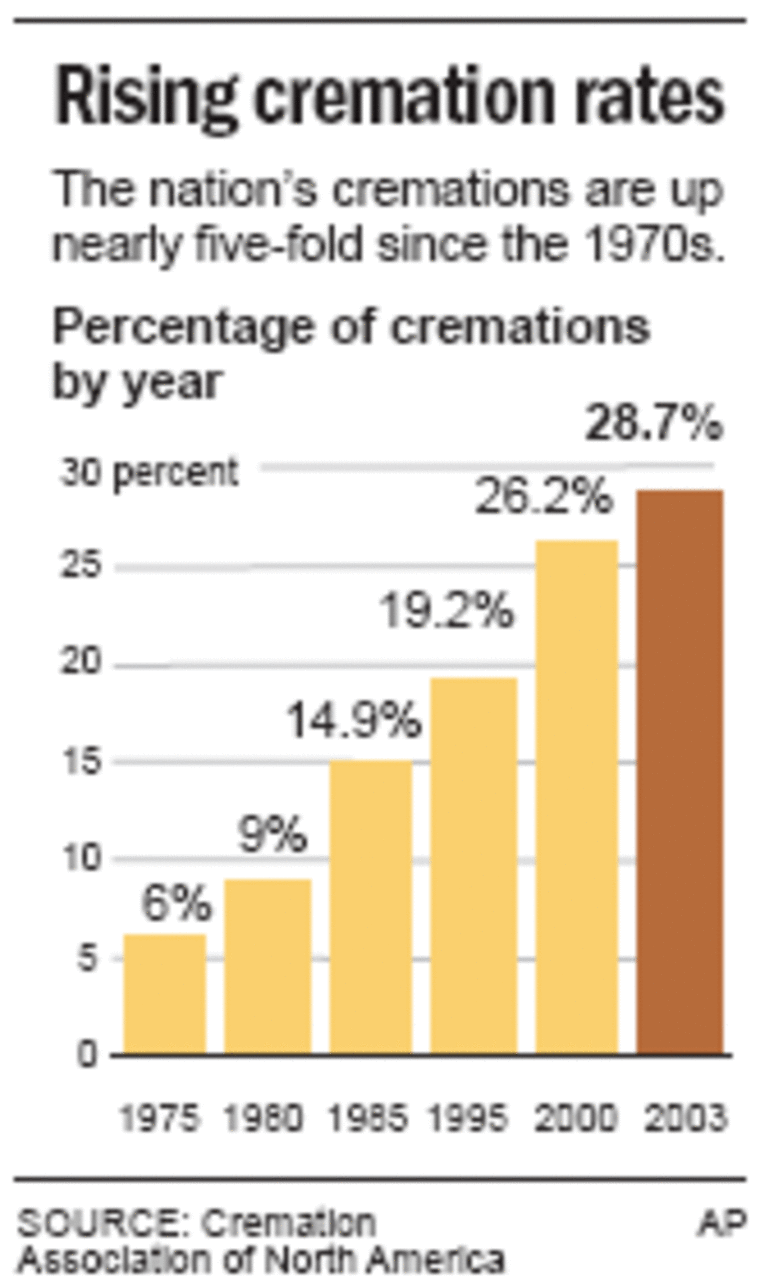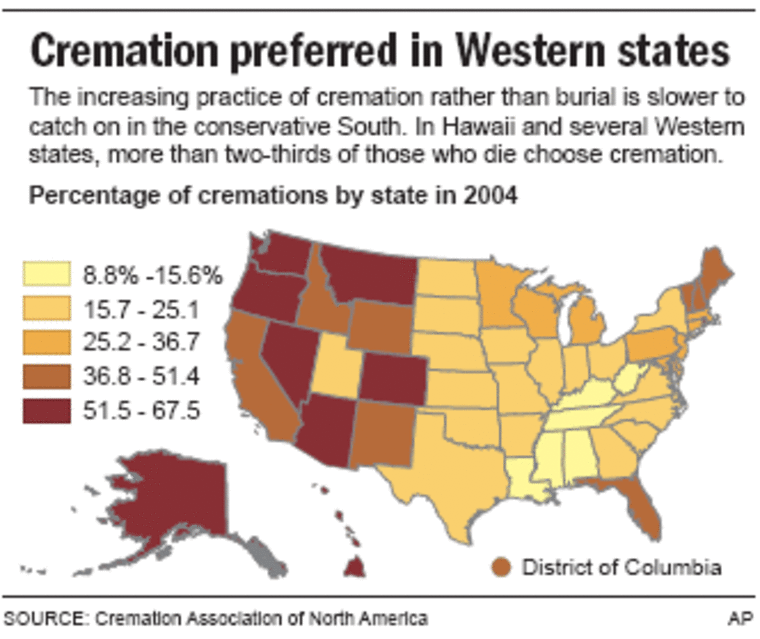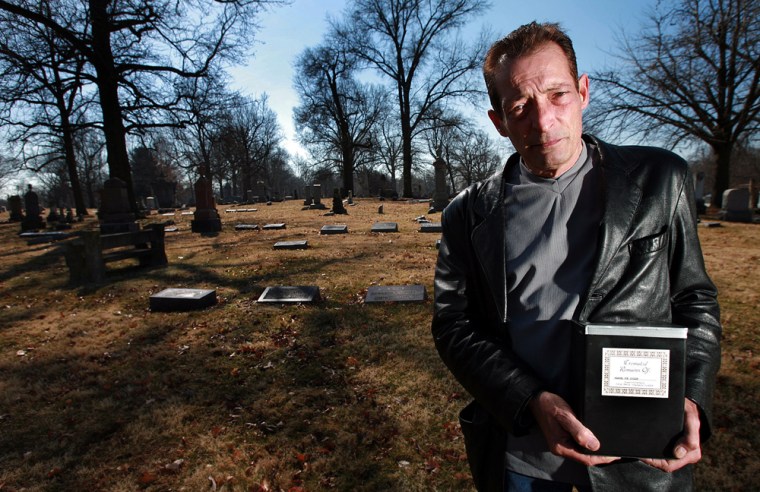Beth McGinley has no use for burial plots. She wants her friends to sprinkle her ashes somewhere memorable when she dies.
“My main motivating factor is the cost of funerals,” said McGinley, 53, of Indianapolis, who began planning her cremation after being diagnosed with lung cancer last spring. “That whole industry is not any place I want to spend my money.”
Millions of people like McGinley are shunning traditional burials in favor of cremation, whose rates have risen to 30 percent of funeral arrangements and are poised to climb to more than 45 percent by 2025.
The shift has forced casket makers to retool their traditional business approach, offering new products and packages that include viewings and other elements of traditional services designed to capture cremation customers.
The industry’s big three — Batesville Casket Co., York Casket and Aurora Casket Co.— have introduced their own cremation lines, with items ranging from basic cardboard boxes to $3,000 fully combustible caskets to $12,000 one-of-a-kind urns. Batesville produces a glossy, Pottery Barn-style cremation catalog whose “spring/summer” cover features a single purple flower blooming from a gleaming Nambe keepsake urn.
“They’ve all diversified into cremation products, trying to lose the burial business to themselves,” said Elliott Schlang, an analyst at Soleil Securities’ Great Lakes Review who covers Matthews International Corp. and Hillenbrand Industries Inc., parent companies of York and Batesville.
Cremation as a modern practice began gaining mass appeal in the U.S. in the 1960s, thanks in part to a Vatican blessing of the practice.

In 1970, nearly everyone used a casket, but by 2005, that figure had dropped to about 71 percent, said George W. Lemke, executive director of the Lake Bluff, Ill.-based Casket and Funeral Supply Association.
Some of the shift is attributed to cost. A basic cremation, which requires little more than a cardboard box for the body and a container for cremains, can cost thousands less than a traditional burial with high-end casket, burial plot, viewings and full funeral service.
But Stephen Prothero, chairman of the religion department at Boston University and author of the book “Purified by Fire,” thinks the rising popularity of cremation is tied more to the nation’s blossoming counterculture and a new sense of spirituality.
“Burial has been associated, at least for the baby boomers, with being overwrought and overdone and too traditional and cookie cutter,” Prothero said. “You get this argument that burial is big and ugly and corporate and fat and it’s the Cadillac. Cremation is hip and new and happening — it’s the VW bug with the ’small is beautiful’ kind of thing,” he said.

Cremation rates are highest in western states. Hawaii has the highest rate — 67.5 percent. Nevada and Washington follow with 67.1 percent and 65.1 percent, respectively. But the practice has affected casket makers nationwide, including Aurora Casket in southeastern Indiana.
Jason Barrott, the company’s director of marketing development, is the fifth generation of his family to work in the business.
“When my dad was my age, it was probably harder for him to think too much about a 30 percent cremation rate,” Barrott said. “Now it’s here and we can’t ignore it. We have to keep coming up with innovative ways to allow our customers to better present cremation, and, at the same time, something that allows [funeral homes] to be more profitable with cremation.”
In December, Aurora debuted its Journey line, branding for the first time its urns, cremation caskets and tokens for families.
Casket makers and funeral homes also have developed packages combining cremation with elements of a traditional burial, such as viewings, memorial services and carved stone markers.
“The memorialization and services that get attached with cremation can be equally as beautiful and can inspire anyone,” said Steve Schaal, a spokesman for the cremation division of Pittsburgh-based Matthews.
Those add-ons can be pricey.
The average cremation — without the cost of burial and other fees — is about $1,850, said Jack Springer, executive director of the Cremation Association of North America. But add an elaborate urn, a hand-carved wooden casket, full funeral or fees for space in a columbarium and the price can rival, if not exceed, a traditional burial, which runs about $6,000 not including a plot and other fees.
McGinley, who planned her funeral with Crown Hill Cemetery and Funeral Home in Indianapolis, won’t say what she plans to spend. But she’s glad she chose cremation over burial.
“The idea of having your very own spot on the Earth, it’s just not a very compelling thing,” she said.
Todd Dashley, executive vice president at Crown Hill, said those who choose cremation typically have a strong sense of spirituality and are open to having their ashes scattered in more than one place. The 555-acre cemetery includes a wooded garden, dotted with stone markers and inscribed benches, where ashes can be scattered.
“I think where people get caught up in tradition versus cremation is in the spiritual side of them,” Dashley said. “When their focus is their body, then the thought of separating mom three ways is offensive. When they’ve made peace that their mom has gone to a better place, or whatever their spiritual inclination is, the body is not the focal point.”
Bob Sinclair, who operates two funeral homes in North Carolina’s foothills, said the possibilities for cremation are endless.
“It is physically possible that someone who’s cremated may travel more after death than they did in true life,” Sinclair said.
Joe Sigler of Indianapolis likes to think so.
Sigler, 53, grew up with the three-day viewings and funeral ceremonies traditional to his Spanish heritage. He was surprised when his 77-year-old father decided to be cremated.
Sigler sprinkled some of his father’s ashes along the Gulf Coast at a family ceremony and plans to spread the rest during a trip to Spain next summer. He hopes his family will do the same for him when his time comes.
“I believe when you cremate someone, it’s the old saying of ashes to ashes, dust to dust,” Sigler said. “I don’t get $15,000 funerals.”
